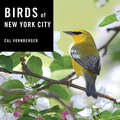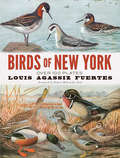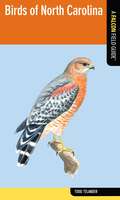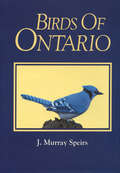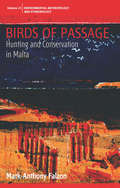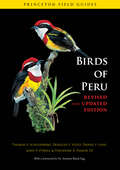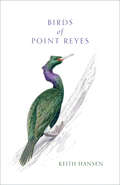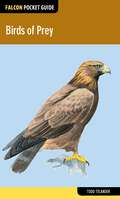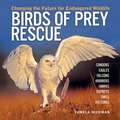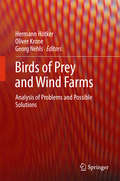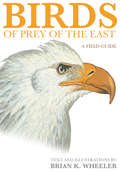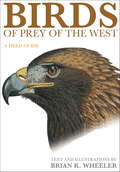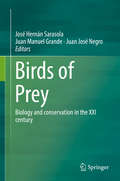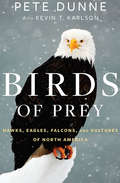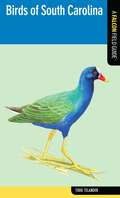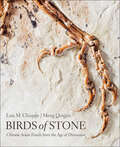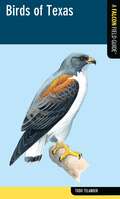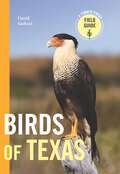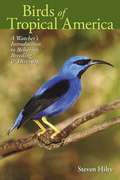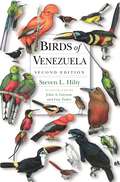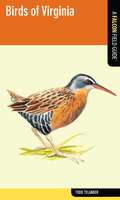- Table View
- List View
Birds of New York City
by Cal VornbergerSee the concrete jungle revealed as a secret habitat for an array of avian life Many marvelous species of bird call New York’s boroughs home, though it takes a keen eye to spot them. Birds of New York City is the culmination of years of work from photographer Cal Vornberger. The product of a master photographer’s patience and ardor, Vornberger’s spectacular images, taken across all five boroughs in all four seasons, reveal an urban environment teeming with wildlife only steps away from speeding cabs and rushing pedestrians. Accompanying these expertly captured images are Vornberger’s engaging anecdotes about his experiences birding in the city, along with helpful photography tips for professionals, hobbyists, or even interested novices, including a detailed list of his trusted equipment. More than two hundred species pass through New York each year, about one-third of the species found in the entire country. With hundreds of dazzling pictures taken year-round and city-wide, Birds of New York City brings these elusive creatures to light for readers everywhere to experience.
Birds of New York: Over 100 Plates
by Louis Agassiz FuertesIn 1910 and 1914, a two-volume study of New York's native birds was issued as part of the State Museum's annual report. A vast catalog of hundreds of species, the survey was illustrated by Louis Agassiz Fuertes (1874–1927), a rising star in scientific bird studies. Fuertes was highly influenced by John James Audubon's The Birds of America, and today he ranks second only to Audubon in terms of output and recognition for ornithological illustration. A frequent lecturer at Cornell University, he honed his expertise during numerous scientific expeditions throughout the United States and abroad, collaborating with Frank Chapman of the American Museum of Natural History on field research, museum dioramas, and book illustrations. This reproduction of all 106 of Fuertes's stunning full-color images spotlights more than 300 birds. It marks the first time that the artwork from Birds of New York has been available in decades, and the volume has never been so affordable. The captions have been reset for easy identification, and a complete Index offers a quick reference. Noted Fuertes expert Robert McCracken Peck provides an informative Foreword. Bird watchers at all levels of experience as well as illustrators, artists, and naturalists will find this book an excellent resource.
Birds of North Carolina (Falcon Field Guide Series)
by Todd TelanderFalcon Field Guides[TM] are full-color, visually appealing, on-the-go guides for identifying plants and animals and learning about nature.
Birds of Ontario (Vol #1)
by Robert Bateman J. Murray SpeirsThis extensive and long overdue work of reference covers all of the bird species, more than 400 of which have been recorded in the province of Ontario. Birds of Ontario contains an identification and description of all species, with 344 outstanding colour plates. Anyone with even a casual interest in birds will find the colour plates and informative text of considerable interest. This volume contains a list of all the birds identified in Ontario up to the end of 1983, with the common and scientific names given by the American Ornithologists’ Union 1983 Check-list as arranged in that work.
Birds of Paradise
by Irena HoareHow many different kinds of birds of paradise? Where do birds of paradise live? What colors are birds of paradise? Find the answers to these questions, and learn much more about the physical characteristics, behavior, habitat, and lives of birds of paradise.
Birds of Passage: Hunting and Conservation in Malta (Environmental Anthropology and Ethnobiology #25)
by Mark-Anthony FalzonBird migration between Europe and Africa is a fraught journey, particularly in the Mediterranean, where migratory birds are shot and trapped in large numbers. In Malta, thousands of hunters share a shrinking countryside. They also rub shoulders with a strong bird-protection and conservation lobby. Drawing on years of ethnographic fieldwork, this book traces the complex interactions between hunters, birds and the landscapes they inhabit, as well as the dynamics and politics of bird conservation. Birds of Passage looks at the practice and meaning of hunting in a specific context, and raises broader questions about human-wildlife interactions and the uncertain outcomes of conservation.
Birds of Passage: Hunting and Conservation in Malta (Environmental Anthropology and Ethnobiology #25)
by Mark-Anthony FalzonBird migration between Europe and Africa is a fraught journey, particularly in the Mediterranean, where migratory birds are shot and trapped in large numbers. In Malta, thousands of hunters share a shrinking countryside. They also rub shoulders with a strong bird-protection and conservation lobby. Drawing on years of ethnographic fieldwork, this book traces the complex interactions between hunters, birds and the landscapes they inhabit, as well as the dynamics and politics of bird conservation. Birds of Passage looks at the practice and meaning of hunting in a specific context, and raises broader questions about human-wildlife interactions and the uncertain outcomes of conservation.
Birds of Peru
by Douglas F. Stotz Theodore A. Parker III John P. O'Neill Thomas S. Schulenberg Daniel F. Lane Antonio Brack EggBirds of Peru is the most complete and authoritative field guide to this diverse, neotropical landscape. It features every one of Peru's 1,817 bird species and shows the distinct plumages of each in 307 superb, high-quality color plates. Concise descriptions and color distribution maps are located opposite the plates, making this book much easier to use in the field than standard neotropical field guides. This fully revised paperback edition includes twenty-five additional species.A comprehensive guide to all 1,817 species found in Peru--one fifth of the world's birds--with subspecies, sexes, age classes, and morphs fully illustrated Designed especially for field use, with vivid descriptive information and helpful identification tips opposite color plates Detailed species accounts, including a full-color distribution map Includes 25 additional species not covered in the first edition Features 3 entirely new plates and more than 25 additional illustrations
Birds of Peru
by Dr Antonio Brack Egg Douglas F. Stotz Theodore A. Parker III John P. O'Neill Thomas S. Schulenberg Daniel F. LaneBirds of Peru is the most complete and authoritative field guide to this diverse, neotropical landscape. It features every one of Peru's 1,817 bird species and shows the distinct plumages of each in 307 superb, high-quality color plates. Concise descriptions and color distribution maps are located opposite the plates, making this book much easier to use in the field than standard neotropical field guides. This fully revised paperback edition includes twenty-five additional species. A comprehensive guide to all 1,817 species found in Peru--one fifth of the world's birds--with subspecies, sexes, age classes, and morphs fully illustrated Designed especially for field use, with vivid descriptive information and helpful identification tips opposite color plates Detailed species accounts, including a full-color distribution map Includes 25 additional species not covered in the first edition Features 3 entirely new plates and more than 25 additional illustrations
Birds of Point Reyes
by Keith HansenA richly illustrated guide celebrates California’s coastal birds and the wonders of witnessing them."A compact treasury of natural history knowledge." —Burr Heneman, former executive director of Point Reyes Bird Observatory"A meditation on beauty and survival." —Amy Tan, author of The Joy Luck ClubA birding paradise, Point Reyes National Seashore boasts a breathtaking coastline that attracts an array of winged beauties and their flightless fanciers year-round. Both a waystation for feathered vagrants and home to a wealth of native species, this coastal sanctuary is teeming with avian life, and in Birds of Point Reyes expert birder and ornithological illustrator Keith Hansen celebrates this airborne abundance. From the sparrows and cormorants to the hawks and ravens to the wild wanderers who sweep through in vast seasonal migrations, Hansen introduces readers to the wildlife that soar and swirl overhead through over 25 awe-filled portraits of Point Reyes’s birds. Both experienced birdwatchers and less-than-expert birders will delight in Hansen’s reflections, brought vividly to life by full-color artworks that reward the reader’s sustained attention and help to identify the many-splendored species of the region. With this guide Hansen invites readers to imagine the world’s fastest hunt through the eyes of a cliff-dwelling peregrine, to appreciate the evolutionary complexity of the shorebird beaks prodding the sands of Drakes Bay, and to attune to the serenade of birdsong. Grab your binoculars and get ready to see these birds like never before.
Birds of Prey (Falcon Pocket Guides)
by Todd TelanderFalcon Pocket Guide: Birds of Prey is a field guide to the 55 birds of prey in North America. Anatomically correct illustrations of the birds in flight and on the ground and detailed descriptions about each bird's prominent physical attributes and natural habitat make it easy to identify birds in your backyard, favorite parks, and wildlife areas. Informative and beautiful to peruse, this is the essential resource when you're out in the field.Falcon Pocket Guides are full-color, visually appealing, on-the-go guides for identifying plants and animals and learning about nature.
Birds of Prey Rescue: Changing the Future for Endangered Wildlife
by Pamela HickmanBirds of prey, otherwise known as raptors, have been respected and admired yet also feared and loathed throughout their existence. They are meat-eating birds and extremely well-equipped for the hunt, with powerful eyesight, ultra-sensitive hearing, and sharp talons. Despite these apparent advantages, many birds of prey species are seriously endangered or threatened.This latest addition to the Firefly Animal Rescue series profiles the dedicated people and projects around the world helping raptors to survive, including: The Philippine Eagle Foundation that is bringing the Philippine eagle back from the brink of extinction; Lindsay Oaks, an American microbiologist, who helped discover what is killing vultures in Asia; Sophie Osborn, who monitors released California condors; The biologists using Peregrine falcons as "foster parents" for the young of the endangered South American aplomado falcon. Illustrated with 50 spectacular color photographs, Birds of Prey Rescue also addresses the general biological issues and challenges in preserving a future for endangered wildlife.
Birds of Prey and Wind Farms: Analysis of Problems and Possible Solutions
by Hermann Hötker Oliver Krone Georg NehlsThis book discusses the increase in number and capacity of wind farms in Germany and how this is affecting birds of prey. Several methods are used to study the behaviour of birds of prey in relation to wind farms, including telemetry data, field observations, and comparisons of turbine base areas. Special attention is given to the effects on different bird species and the impact wind farms may have on population growth and breeding success of birds of prey. Chapter 6 discusses the collision risks at wind turbines and provides an analysis of the fatalities. In the concluding chapter, ideas are put forward to help minimize conflicts, estimate risks, and offer practical recommendations for future research. This book will be of interest to wind farm developers, researchers, applied ecologists and landscape planners.
Birds of Prey of the East: A Field Guide
by Brian K. WheelerBirds of Prey of the East and its companion volume, Birds of Prey of the West, are the most comprehensive and authoritative field guides to North American birds of prey ever published. Written and lavishly illustrated with stunning, lifelike paintings by leading field-guide illustrator, photographer, and author Brian Wheeler, the guides depict an enormous range of variations of age, sex, color, and plumage, and feature a significant amount of plumage data that has never been published before. The painted figures illustrate plumage and species comparisons in a classic field-guide layout. Each species is shown in the same posture and from the same viewpoint, which further assists comparisons. Facing-page text includes quick-reference identification points and brief natural history accounts that incorporate the latest information. The range maps are exceptionally accurate and much larger than those in other guides. They plot the most up-to-date distribution information for each species and include the location of cities for more accurate reference. Finally, the guides feature color habitat photographs next to the maps. The result sets a new standard for guides to North America's birds of prey.Lavishly illustrated with stunning, lifelike paintingsWritten and illustrated by a leading authority on North American birds of preyDepicts more plumages than any other guideConcise facing-page text includes quick-reference identification pointsClassic field-guide layout makes comparing species easyLarge, accurate range maps include up-to-date distribution informationUnique color habitat photographs next to the maps
Birds of Prey of the West: A Field Guide
by Brian K. WheelerBirds of Prey of the West and its companion volume, Birds of Prey of the East, are the most comprehensive and authoritative field guides to North American birds of prey ever published. Written and lavishly illustrated with stunning, lifelike paintings by leading field-guide illustrator, photographer, and author Brian Wheeler, the guides depict an enormous range of variations of age, sex, color, and plumage, and feature a significant amount of plumage data that has never been published before. The painted figures illustrate plumage and species comparisons in a classic field-guide layout. Each species is shown in the same posture and from the same viewpoint, which further assists comparisons. Facing-page text includes quick-reference identification points and brief natural history accounts that incorporate the latest information. The range maps are exceptionally accurate and much larger than those in other guides. They plot the most up-to-date distribution information for each species and include the location of cities for more accurate reference. Finally, the guides feature color habitat photographs next to the maps. The result sets a new standard for guides to North America's birds of prey.Lavishly illustrated with stunning, lifelike paintingsWritten and illustrated by a leading authority on North American birds of preyDepicts more plumages than any other guideConcise facing-page text includes quick-reference identification pointsClassic field-guide layout makes comparing species easyLarge, accurate range maps include up-to-date distribution informationUnique color habitat photographs next to the maps
Birds of Prey: Biology and conservation in the XXI century
by José Hernán Sarasola Juan Manuel Grande Juan José NegroThis book will provide the state-of-the-art on most of the topics involved in the ecology and conservation of birds of prey. With chapters authored by the most recognized and prestigious researchers on each of the fields, this book will become an authorized reference volume for raptor biologists and researchers around the world.
Birds of Prey: Hawks, Eagles, Falcons, and Vultures of North America
by Kevin T. Karlson Pete DunneA visually stunning, comprehensive resource on North America&’s birds of prey, from the award-winning birder and author of Gulls Simplified.Always a popular group of birds, raptors symbolize freedom and fierceness, and in Pete Dunne&’s definitive guide, these traits are portrayed in hundreds of stunning color photographs showing raptors up close, in flight, and in action—fighting, hunting, and nesting. These gorgeous photographs enhance the comprehensive, authoritative text, which goes far beyond identification to cover raptor ecology, behavior, conservation, and much more. In returning to his forte and his first love, Pete Dunne has crafted a benchmark book on raptors: the first place to turn for any question about these highly popular birds, whether it&’s what they eat, where they live, or how they behave. &“Birds of Prey is exhaustively researched and complemented by a stunning collection of photos, but the real highlight is…Dunne&’s writing. He weaves together personal anecdotes, historical accounts, and technical information to create something greater than the sum of all its parts: a beautiful, authoritative, and engagingly written guide to the natural history of North American hawks.&”—David Sibley, author of The Sibley Guide to Birds&“Books about raptors used to fall into two major categories: field guides versus nature writing. No more!...Dunne&’s new book skillfully conjoins those two genres. Life a good field guide, Birds of Prey is authoritative and utilitarian, and like our finest nature writing, Dunne&’s prose is lyrical, sensitive, and full of feeling.&”—Ted Floyd, editor, Birding
Birds of South Carolina (Falcon Field Guide Series)
by Todd TelanderFalcon Field Guides[TM] are full-color, visually appealing, on-the-go guides for identifying plants and animals and learning about nature.
Birds of Stone: Chinese Avian Fossils from the Age of Dinosaurs
by Luis M. Chiappe Meng QingjinCaptivating photographs of the world’s most detailed bird fossils illuminate the early diversity of avifauna.When fossils of birds from China’s Jehol region first appeared in scientific circles, the world took notice. These Mesozoic masterpieces are between 120 and 131 million years old and reveal incredible details that capture the diversity of ancient bird life. Paleontologists all over the world began to collaborate with Chinese colleagues as new and wondrous fossil-related discoveries became regular events. The pages of National Geographic and major scientific journals described the intricate views of feathers as well as food still visible in the guts of these ancient birds. Now, for the first time, a sweeping collection of the most interesting of Jehol’s avian fossils is on display in this beautiful book. Birds of Stone makes visible the unexpected avian diversity that blanketed the earth just a short time (geologically speaking) after a dinosaur lineage gave rise to the first birds. Our visual journey through these fossils is guided by Luis M. Chiappe, a world expert on early birds, and Meng Qingjin, a leading figure in China's natural history museum community. Together, they help us understand the "meaning" of each fossil by providing straightforward narratives that accompany the full-page photographs of the Jehol discoveries. Anyone interested in the history of life—from paleontologists to inquisitive birders—will find Birds of Stone an irresistible feast for the eyes and mind.
Birds of Texas (Falcon Field Guide Series)
by Todd TelanderEach Falcon Field Guide to birds introduces the 180 most common and sought-after species in a state. Conveniently sized to fit in your pocket and featuring full-color, detailed illustrations, these informative guides make it easy to identify birds in a backyard, favorite parks, and wildlife areas. Each bird is accompanied by a detailed listing of its prominent attributes and a color illustration showing its important features. Birds are organized in taxonomic order, keeping families of birds together for easy identification. This is the essential source for the field, both informative and beautiful to peruse.
Birds of Texas: A Timber Press Field Guide (A Timber Press Field Guide)
by David SarkoziA comprehensive field guide to the birds of Texas, with nearly 500 species, excellent photography, and nuanced information on how to locate and identify each bird.Birds of Texas includes local favorites and rare curiosities that can be found in the lonestar state. This full-color guide includes precise descriptions of voices, behaviors, habitats, and details the top birding sites across the the state. ·Covers every county in Texas, and the state's border regions ·Describes and illustrates bird species ·Over 800 spectacular photographs of relevant plumages and birds in flight ·Individual range maps for each bird show seasonal and migratory patterns ·Easy to use for beginners and experts alike
Birds of Tropical America: A Watcher's Introduction to Behavior, Breeding, and Diversity
by Steven HiltyBirds of Tropical America was published by Chapters Publishing in 1994 and went out of print in 1997. UT Press is pleased to reissue it with a new epilogue and updated references.
Birds of Venezuela
by Steven L. HiltyVenezuela has an immensely rich bird fauna, with 1,381 known species, many of them found nowhere else in the world. This spectacularly illustrated, comprehensive, and up-to-date guide brings together under one cover much of what is known about these species. Its users can identify all the birds in this vast country, from the Caribbean coast in the north to the Amazonian jungles in the south, from the Andes in the west to the Gran Sabana plateau in the east. With a completely new text by Steven Hilty, Birds of Venezuela is a greatly expanded and thoroughly reformatted successor to the pioneering Guide to the Birds of Venezuela (Princeton,1978). It includes sixty-seven beautiful color and black-and-white plates, most by the well-known artists John Gwynne and Guy Tudor, as well as numerous line drawings. The plates and drawings together--almost half of them never before published--depict most of Venezuela's bird species. Introductory chapters cover physical geography, climate, biogeography, vegetation and habitats, conservation, migration, and the history of ornithology in Venezuela. A gallery of forty-four stunning color habitat photos and color habitat and relief maps complete the opening section. Detailed range maps plot collection localities and sight records--a unique feature--for almost all species. Plumage descriptions are provided for each bird, as is extensive information on voice, behavior, and status. More than 800 bibliographic entries accompany the text, making this book an invaluable and broad-based reference to the avifauna of not only Venezuela but much of northern South America. Treating nearly 40 percent of the continent's bird species, Birds of Venezuela is the definitive resource for all birders with an eager eye on this splendorous country and the surrounding region. The most comprehensive, up-to-date, and best illustrated guide to the birds of Venezuela Covers all 1,381 known species and their subspecies from the Caribbean coast to the jungles of the Amazon, from the Andes to the Gran Sabana plateau--nearly 40 percent of all bird species in South America Completely new text accompanied by more than 800 bibliographic entries Strikingly illustrated with 67 color and black & white plates and numerous line drawings 44 stunning color habitat photos and color habitat and relief maps Detailed range maps for each species
Birds of Virginia (Falcon Field Guide Series)
by Todd TelanderFalcon Field Guides[TM] are full-color, visually appealing, on-the-go guides for identifying plants and animals and learning about nature.
Birds of West Virginia (Falcon Field Guide Series)
by Todd TelanderFalcon Field Guides[TM] are full-color, visually appealing, on-the-go guides for identifying plants and animals and learning about nature.
